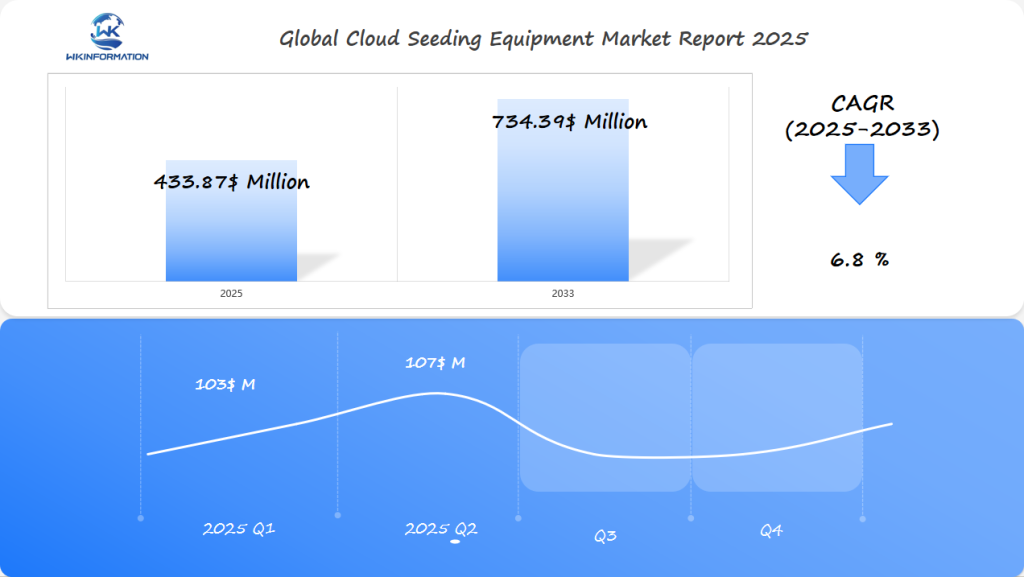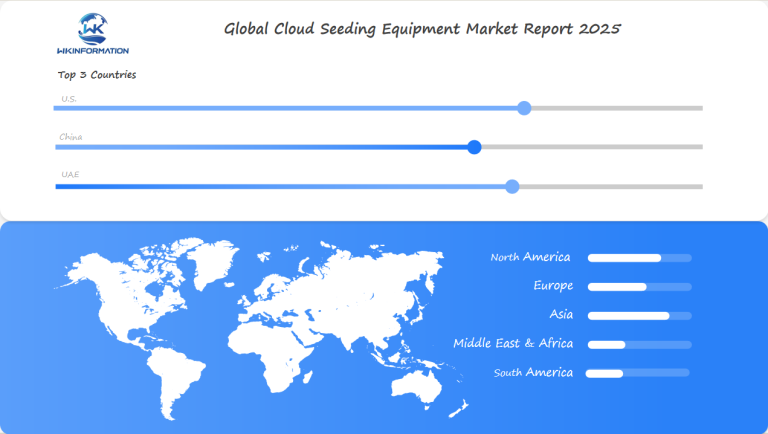Cloud Seeding Equipment Market Expected to Surpass $433.87 Million by 2025: Demand Growth in the U.S., China, and UAE
Explore the expanding Cloud Seeding Equipment Market driven by weather modification demands. Get insights on aerial & ground-based systems, regional analysis, and key players.
- Last Updated:
Cloud Seeding Equipment Market in Q1 and Q2 of 2025
The Cloud Seeding Equipment market is estimated to reach $433.87 million in 2025, growing at a CAGR of 6.8% from 2025 to 2033. In Q1 2025, the market size is expected to be $103 million, increasing to $107 million in Q2. This market is expanding due to increasing concerns over water scarcity and the growing demand for climate change mitigation solutions.
The U.S. and China continue to lead in cloud seeding technology research and development, with ongoing government projects aimed at enhancing regional water supplies. The UAE is also increasing its investments in cloud seeding to improve rainfall in arid regions, which could further accelerate the market’s growth. The global emphasis on agricultural efficiency and water conservation strategies is creating new opportunities for cloud seeding technologies. As climate change accelerates, more regions are expected to adopt such technologies to secure water resources and improve weather patterns.

Key Takeaways
- Cloud seeding market expected to exceed $433.87 million by 2025
- Growing demand for weather modification technology in water-scarce regions
- United States, China, and UAE leading global cloud seeding initiatives
- Technological advancements driving market expansion
- Potential for significant agricultural and environmental impact
Upstream and Downstream Industry Chain Analysis in Cloud Seeding Equipment
The cloud seeding supply chain is a complex web of technologies and manufacturers. They work together to improve weather control. Weather modification equipment makers are key in creating systems for precise weather changes.
Key Parts of the Cloud Seeding Supply Chain
The following are the key parts of the cloud seeding supply chain:
- Raw material suppliers specializing in advanced chemical compounds
- Precision engineering firms producing specialized equipment
- Research institutions developing cutting-edge weather manipulation technologies
- Government and private sector deployment agencies
Impact of COVID-19 on the Supply Chain
The COVID-19 pandemic hit the supply chain hard. It made it tough for manufacturers to get the parts they need. This caused delays in making and using cloud seeding equipment. It showed how fragile tech supply chains can be.
Importance of Partnerships
Now, partnerships between makers and researchers are more crucial. They help speed up new tech and make cloud seeding better.
New Trends in Cloud Seeding
New trends in cloud seeding show a move towards:
- More eco-friendly chemicals
- Systems that hit their mark better
- Cloud seeding that can reach more areas
- AI for better weather predictions
Need for a Strong Supply Chain
The cloud seeding supply chain needs to be strong and flexible. It’s key for solving global water issues and adapting to climate changes.
Emerging trends in weather modification technologies and climate change adaptation
Cloud seeding innovations are changing how we tackle climate challenges. Researchers and tech experts are exploring new ways to modify the weather. This is to meet the growing needs of our environment.
New cloud seeding technology
New cloud seeding tech aims to be more precise and effective. Some key advancements include:
- Drone-based cloud seeding systems
- AI-powered weather prediction algorithms
- Advanced chemical seeding materials
- Satellite-guided targeting mechanisms
Today’s climate resilience strategies
Today’s climate resilience strategies use advanced tech. Scientists are working on cloud seeding methods that are better for the environment. These methods aim to increase water production while reducing harm to nature.
| Technology | Key Innovation | Potential Impact |
| Autonomous Drone Seeding | Precision targeting of cloud formations | Increased precipitation efficiency |
| AI Weather Modeling | Advanced predictive algorithms | More accurate intervention strategies |
| Nano-engineered Seeding Materials | Enhanced precipitation nucleation | Reduced chemical environmental impact |
Importance of cloud seeding innovations
Cloud seeding innovations are key for managing water in dry areas. Researchers are looking into more advanced weather modification methods. They aim to find a balance between tech capability and environmental care.
As water scarcity grows, these new technologies offer hope. They help us find better ways to adapt to climate change.
Regulatory barriers and ethical considerations in cloud seeding practices
Cloud seeding faces many challenges due to complex laws. Governments around the world struggle with these laws. They must balance new science with protecting the environment.
Key things to consider include:
- Environmental impact assessments
- Potential transboundary weather alterations
- Scientific verification of cloud seeding outcomes
- Public safety and ecosystem protection
Different places have different rules for cloud seeding. The U.S. is careful, needing lots of science and studies before starting. Ethical questions are key in deciding what’s okay in the skies.
Experts and leaders are still figuring out cloud seeding’s effects. They worry about:
- Long-term ecological impacts
- Potential climate system disruptions
- Economic implications for agricultural and water resource management
As climate issues grow, making good cloud seeding laws is more important. Everyone must find a way to use new tech while caring for the planet. This ensures weather changes help everyone, not just a few.

Geopolitical factors influencing regional weather patterns and water resource management
Cloud seeding geopolitics is now a key area in international environmental strategy. Countries are using weather modification technologies to tackle water scarcity and climate issues. These actions create complex diplomatic situations where national interests meet environmental management.
Managing shared water resources is a big challenge. Countries use cloud seeding to change the weather, which can lead to tensions with neighbors. They might see these actions as interfering with their climate.
Potential impacts of cloud seeding on geopolitics
- Cloud seeding can alter precipitation patterns across national borders
- Technological interventions may create diplomatic friction between countries
- Water resource management becomes increasingly complex with atmospheric manipulation
Key geopolitical considerations in cloud seeding
| Region | Geopolitical Dynamics | Potential Conflicts |
| Middle East | Water Scarcity Challenges | Competing National Interests |
| Central Asia | Shared River Basins | Upstream-Downstream Tensions |
| North America | Collaborative Research | Regulatory Coordination |
The future of cloud seeding geopolitics will need global cooperation. It’s important to develop clear rules for managing shared water resources. This is crucial as countries look for new ways to deal with climate challenges.
Type segmentation: aircraft-based, ground-based, and aerial cloud seeding systems
Cloud seeding equipment is key in weather modification. The market has two main types: aerial and ground-based systems. Each has its own way of changing the weather and managing water resources.
Aerial vs ground-based seeding systems work differently. Aircraft-based systems can cover wide areas and target specific zones. They can spread cloud seeding agents over big areas quickly.
- Aircraft-based cloud seeding offers broader geographic reach
- Ground-based systems provide localized and controlled interventions
- Each method requires specialized equipment and technical expertise
Nowadays, people prefer aerial cloud seeding equipment more. Advanced aircraft with cloud seeding tech can handle tough weather better than ground systems.
| Equipment Type | Coverage Range | Operational Flexibility |
| Aerial Cloud Seeding | Large geographic areas | High mobility and rapid deployment |
| Ground-Based Cloud Seeding | Localized regions | Precise, controlled interventions |
Technology keeps getting better for both aerial and ground-based systems. Scientists are working hard to make them more efficient and less harmful to the environment. They also aim to improve how cloud seeding agents are spread.
Application segmentation: agriculture, water conservation, and disaster management
Cloud seeding is a key strategy for solving water problems in many areas. It has the power to change how we manage water for farming, saving water, and handling disasters.
Agriculture
Using weather modification for farming is a new way to make crops stronger. Farmers in dry areas use cloud seeding to fight water shortages. This method helps bring rain and keeps farming going even when it’s hard.
Experts have found important uses for cloud seeding:
- Agricultural Sector: Making more rain during key growing times
- Urban Water Management: Helping cities with their water needs
- Disaster Mitigation: Lowering risks of wildfires and droughts
The market for cloud seeding is growing fast. In 2023, areas with droughts used cloud seeding the most. This shows how important it is for solving water problems worldwide.
Water Conservation
Cloud seeding can also play a significant role in water conservation efforts. By increasing precipitation in specific regions, it can help replenish reservoirs, aquifers, and other water sources that are crucial for sustaining ecosystems and meeting human water demands.
Disaster Management
In addition to its applications in agriculture and water conservation, cloud seeding has potential benefits for disaster management. By inducing rainfall in areas prone to wildfires or droughts, it can help mitigate the impacts of these natural disasters and protect vulnerable communities.
Overall, cloud seeding holds promise as a versatile tool for addressing various challenges related to water scarcity and environmental resilience.
Global adoption of cloud seeding as a climate resilience strategy
Cloud seeding is becoming a key strategy for countries facing water shortages and climate issues. Around the world, nations are using new ways to control rain and improve water supplies.
Countries Using Cloud Seeding Technology
Some of the main places using cloud seeding technology are:
- United States
- China
- United Arab Emirates
- Israel
- India
Weather modification strategies are getting more advanced. Governments are putting a lot of money into cloud seeding to fight drought, help farming, and manage water.
Recent numbers show cloud seeding is really taking off. For example, China did a huge weather project in 2020. It covered over 5.5 million square kilometers, showing how effective these technologies can be.
Reasons for the Global Popularity of Cloud Seeding
What’s making cloud seeding more popular globally includes:
- Increasing water scarcity
- Agricultural sustainability
- Climate change adaptation
- Technological advancements
The outlook for weather modification is bright. With ongoing research and teamwork, cloud seeding can help tackle worldwide environmental issues.

U.S. market driving innovative weather modification solutions
The United States leads in the U.S. cloud seeding market. It’s at the forefront of American weather modification technology. This technology tackles big environmental challenges.
North America is a major player, with a big market share in 2025. This is thanks to smart investments and leading research.
Several key factors push the U.S. cloud seeding market to innovate:
- Advanced research on drought mitigation
- Teamwork between government and private sector researchers
- Breakthroughs in controlling the atmosphere
States like Arizona are leading in weather modification. In December 2022, Arizona planned to use artificial weather methods to fight drought. This shows how American technology can solve real environmental problems.
Research centers and tech companies are making better cloud seeding tools. These tools aim for more accurate and powerful weather changes. The U.S. cloud seeding market keeps investing in:
- Top-notch weather tracking systems
- Advanced seeding platforms in the air and on the ground
- Strategies based on data for adapting to climate change
American researchers are dedicated to solving big environmental problems with new technology.
China's large-scale cloud seeding programs in drought-prone areas
China is leading the way in weather modification in Asia. They use cloud seeding to fight water scarcity and environmental issues. Their efforts are key to tackling drought in hard-hit areas.
The Chinese government has put a lot of money into cloud seeding tech. They focus on areas with severe water shortages. Their goals are:
- Boosting rain in dry farming zones
- Dealing with water shortages
- Helping crops grow in dry areas
- Improving water security
China’s weather modification efforts are huge. In August 2022, they launched big cloud seeding programs. They aimed to tackle power and water shortages in the Yangtze River basin during a heatwave.
China’s weather projects use new tech like aircraft seeding and ground-based systems. Scientists are working on even better ways to control the weather. This makes China a leader in global weather control.
UAE's use of cloud seeding for water scarcity mitigation
The United Arab Emirates is leading in weather modification in the Middle East. They use cloud seeding technology to tackle water scarcity. Since June 2023, they’ve done twenty-two cloud-seeding missions. This shows their dedication to managing water resources.
UAE’s cloud seeding technology is a smart way to adapt to dry environments. They use advanced methods to make more rain. They target the right conditions in the air with special planes and materials.
- Advanced cloud seeding aircraft deployed across desert regions
- Sophisticated meteorological tracking systems
- Precision targeting of potential precipitation zones
The UAE’s efforts go beyond just getting more water. They’re also a key place for studying climate change solutions. Their work could change how we manage water in tough environments.
The UAE is investing in cloud seeding to solve environmental problems. They keep improving their methods. This could help other places with water issues too.
Future Development in Autonomous Cloud Seeding and AI-Powered Forecasting
The world of weather control is changing fast. New technologies like autonomous cloud seeding and AI weather forecasting are leading the way. They use drones and AI to make rain more accurately than ever before.
How New Tech is Changing Cloud Seeding
New tech in cloud seeding is changing how we manage the weather. Scientists are working on AI systems that can:
- Find the best places to seed clouds with great accuracy
- Guess the weather conditions for the most rain
- Use drones to seed clouds exactly where needed
The UAE’s Role in Advancing Weather Technology
The UAE is leading in these tech advances. They’ve shown how autonomous cloud seeding can really help with water. Drones let scientists reach high places, making AI weather forecasts even better.
Challenges Ahead
But there are still big challenges. We need better AI and drones that can handle tough weather. Yet, the chance to make more water with AI is drawing big investments worldwide.
Competitive landscape of weather modification technology providers
The weather modification industry is getting more competitive. Cloud seeding companies are exploring new technologies. They aim to solve global water and climate issues.
Leading companies in the weather modification industry stand out. They use unique technologies and strategic plans. Their focus is on creating advanced cloud seeding equipment and services.
- Top cloud seeding companies are investing heavily in research and development
- Technological innovations are driving market differentiation
- Strategic partnerships are reshaping the competitive landscape
These companies are tackling big environmental challenges. They mix scientific research with practical solutions.
Overall
| Report Metric | Details |
|---|---|
| Report Name | Global Cloud Seeding Equipment Market Report |
| Base Year | 2024 |
| Segment by Type | · Aerial Cloud Seeding
· Ground-Based Cloud Seeding |
| Segment by Application | · Agriculture
· Water Conservation · Disaster Management · Others |
| Geographies Covered | · North America (United States, Canada)
· Europe (Germany, France, UK, Italy, Russia) · Asia-Pacific (China, Japan, South Korea, Taiwan) · Southeast Asia (India) · Latin America (Mexico, Brazil) |
| Forecast units | USD million in value |
| Report coverage | Revenue and volume forecast, company share, competitive landscape, growth factors and trends |
The cloud seeding market is set for strong growth in the next few years. With water scarcity worldwide getting worse, the outlook for weather modification is bright. Experts predict a big jump in the cloud seeding equipment market, thanks to new tech and climate change strategies.
Recent numbers show the market is growing fast. It started at USD 433.87 million in 2025 and is expected to hit USD 734.39 million by 2033. This growth rate of 6.8% shows more people want advanced weather tech for farming, saving water, and disaster prevention.
The US, China, and the UAE are leading in cloud seeding investments. They’re working on self-driving cloud seeding systems and AI for better forecasts. These advancements will likely boost the market and help manage water resources better.
Players in the weather modification field need to get ready for new challenges and chances. Rules, new tech, and global climate efforts will influence the market. Companies that focus on the latest research and flexible solutions will thrive as demand for cloud seeding grows.
Global Cloud Seeding Equipment Market Report (Can Read by Free sample) – Table of Contents
Chapter 1: Cloud Seeding Equipment Market Analysis Overview
- Competitive Forces Analysis (Porter’s Five Forces)
- Strategic Growth Assessment (Ansoff Matrix)
- Industry Value Chain Insights
- Regional Trends and Key Market Drivers
- Cloud Seeding Equipment Market Segmentation Overview
Chapter 2: Competitive Landscape
- Global Cloud Seeding Equipment Players and Regional Insights
- Key Players and Market Share Analysis
- Sales Trends of Leading Companies
- Year-on-Year Performance Insights
- Competitive Strategies and Market Positioning
- Key Differentiators and Strategic Moves
Chapter 3: Cloud Seeding Equipment Market Segmentation Analysis
- Key Data and Visual Insights
- Trends, Growth Rates, and Drivers
- Segment Dynamics and Insights
- Detailed Market Analysis by Segment
Chapter 4: Regional Market Performance
- Consumer Trends by Region
- Historical Data and Growth Forecasts
- Regional Growth Factors
- Economic, Demographic, and Technological Impacts
- Challenges and Opportunities in Key Regions
- Regional Trends and Market Shifts
- Key Cities and High-Demand Areas
Chapter 5: Cloud Seeding Equipment Emerging and Untapped Markets
- Growth Potential in Secondary Regions
- Trends, Challenges, and Opportunities
Chapter 6: Product and Application Segmentation
- Product Types and Innovation Trends
- Application-Based Market Insights
Chapter 7: Cloud Seeding Equipment Consumer Insights
- Demographics and Buying Behaviors
- TargetAudience Profiles
Chapter 8: Key Findings and Recommendations
- Summary of Cloud Seeding EquipmentMarket Insights
- Actionable Recommendations for Stakeholders

Access the study in MULTIPLEFORMATS
Didn’t find what you’re looking for?
TALK TO OUR ANALYST TEAM
Need something within your budget?
NO WORRIES! WE GOT YOU COVERED!
Call us on: +1-866-739-3133
Email: infor@wkinformation.com

